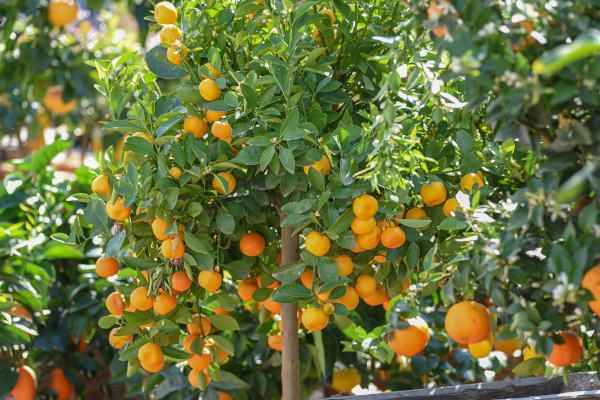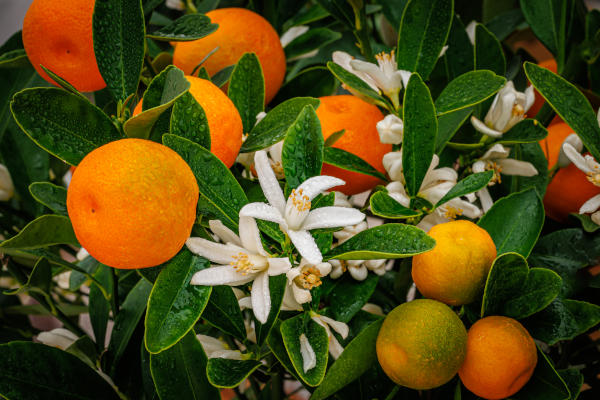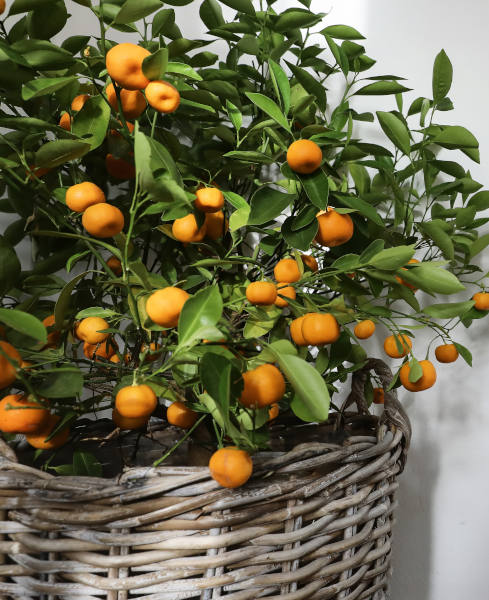How to grow Calamondin
This small evergreen tree is thought to be a naturally occurring hybrid between a kumquat and a mandarin. It produces small, 3-5cm across, fruits which have a tart, sweet/ sour taste, somewhere between a lemon and a satsuma. These can either be eaten whole (skin and all) or used to flavour food and drink.
Calamondin is said to be the hardiest of all citrus trees and is able to withstand temperatures dropping to as low as -5°C. Even so, its best to grow it in a container to allow for overwintering in a protected, indoor environment. Calamondin is widely recommended as the citrus to go for if you don’t have a conservatory or greenhouse, being the most tolerant of the dry, centrally heated air found inside our homes.
Calamondin usually flowers from late spring to late summer, its white, star-shaped flowers emitting a powerful, sweet fragrance. These go on to develop fruits which are small at first then begin to swell in winter. It can take as long as a year for them to fully ripen, though they can be harvested and used at any stage. When green, their tart juice can be squeezed and used in place of lemon juice. For eating whole, the flavour is said to be best when turning from yellow to orange.
The botanic name of calamondin is x Citrofortunella macrocarpa, and it also has several common names, including Philippine lime, acid orange, and citrus calamondin. Its suitability as a houseplant means you’ll often see it sold as a gift in an indoor decorative pot.

Key Information
Position
Soil Conditions
Hardiness


Where & when to plant Calamondin
For best results, pot your calamondin up in spring, then either keep inside permanently as an indoor plant (a conservatory, greenhouse, or sunny windowsill are all ideal), or move outside from mid-June, returning indoors in late September.
Indoors, go for a bright, sunny spot, although one with protection from the hottest, midday sun if you can (this can be scorching when amplified through a window). Outdoors, a sunny spot sheltered from wind is ideal.
How to plant Calamondin
- For best results, choose a terracotta pot just a few centimetres bigger than the rootball, with the intention of repotting into a slightly larger pot every few years. Ensure there are plenty of drainage holes in the bottom.
- If you are using a large or heavy pot, it can be a good idea to fill and plant it in situ to save yourself the trouble of moving once full.
- Use a good quality potting compost – either ericaceous or a specialist citrus compost is best (general, balanced composts tend to be a little too on the alkaline side for citrus). Mix in a generous quantity of horticultural grit.
- Start by partially filling the pot with compost; enough so that when placed on it the upper surface of the root ball is about 3cm lower than the top of the pot.
- Fill around the plant with compost, firming down with your fingers then adding a little more so it is held tight.
- Pick up the container (if you can!) and lightly tap on the potting bench or ground a few times to help further settle the compost around the plant.
- Soak well with water.
- A mulch with horticultural grit will look attractive and help to prevent a ‘cap’ or crust forming on the top of the compost (something container plants can suffer due to the artificial nature of their watering).

How to care for Calamondin
Pruning and Deadheading
Prune in spring, thinning out the centre of the crown to encourage maximum ventilation and light levels throughout. Take off dead, diseased, damaged, or weak branches, as well as any suckers arising from the base.
Trim back again in September to maintain the desired size (and make moving indoors for winter easier).
Make sure you remove all fruit when ripe, as this encourages the formation of newer flowers and fruits. We recommend thinning fruit out for the first few years to redirect energy into healthy plant growth, only allowing it to fruit freely once mature.
Watering
Like all citrus trees, calamondin originates from habitats where the soil is free-draining but the air is humid. The best way to recreate these conditions is to use a well-draining compost mix and stand the container on a saucer filled with gravel, with the water level kept just below the surface of the gravel. During summer, mist the leaves every morning using a spray bottle.
The roots need watering all year round. Aim for a thorough soaking every so often, rather than frequent top ups. Allowing the top 10cm of compost to dry out between soakings is a useful rule of thumb to avoid overwatering. To check this, wiggle your finger down into the compost until you hit a cool, damp bit. Expect to be watering around once a week in the summer, and once a month in the winter. Try to avoid overdoing it in winter – this is the quickest way to kill citrus!
Use harvested rainwater if possible.
Feeding
Unlike many plants, citrus needs feeding all year round. In the growing season (late March to late October), use a high nitrogen summer feed. From late October to late March, switch to a more balanced winter feed. The feed should be mixed into the water when soaking the roots, which means you’ll be applying it weekly in summer and monthly in winter. Specialist citrus feeds are widely available.
Remember also to repot your calamondin every few years, moving up in container size by a few centimetres each time. Once your plant has reached full size, carry out an annual topdress each spring. This involves scraping away the top few centimetres of compost and replacing with fresh (remember to make this ericaceous or specialist citrus compost).
Cold Protection
Despite being the hardiest of all citruses, calamondin still performs best when overwintered indoors. Move inside in late September – a conservatory, greenhouse, or sunny windowsill in the house are all good spots. Keep here until mid-June, when it can go back outside. Alternatively, leave indoors all year round.
Pests and Diseases
Outdoors, calamondin tends to be trouble-free. Indoors, the usual issues of spider mite and mealybug can crop up. Keeping plants as healthy as possible is the key to warding off problems, and by this we mean proper ventilation, adequately spaced plants (for good air flow), keeping everything well-watered and fed, and repotting into larger containers when necessary. Thoroughly cleaning the indoor environment every winter can also help to remove overwintering populations of pests.
Where infestations do take hold, try introducing biological controls (often sachets or tubes containing miniscule natural predators), or in the worst cases, remove the affected plant/s altogether.
How to propagate Calamondin
Take softwood cuttings in spring, using non-flowering, non-fruiting growth.
- Snip cuttings off the plant, aiming for these to be around 20cm.
- Put them in a plastic bag straight away to prevent drying out.
- Fill a pot (or several, if you have multiple cuttings) with a perlite-heavy compost mix (at least 50% perlite).
- Trim the end of the cutting to just below a node (point at which leaves grow).
- Remove all but the top few leaves.
- Insert one cutting per pot and water lightly.
- Place in a greenhouse or propagating unit if you have one, or covered with a polythene bag on a windowsill if not (out of direct sunlight).
- Keep the cuttings misted and occasionally watered until they root. You will know this has happened when they start to produce new leaves – expect this to take around four weeks.
- Remove from the propagating unit or take the plastic bag off, and grow on in a protected, frost-free environment as you would a young tree.
- Calamondin matures very quickly and should be fruiting within a couple of years. Remember though to thin the fruit out for the first few years, so the plant can direct most of its energy into that all-important healthy root and stem formation.
Another, quite fun approach is to collect and sow seed from your calamondin fruit. These trees are self-fertile and will grow readily from the seed they produce.
Leave a few fruits on the tree until they become soft and deep orange.
- Remove seed from the soft flesh, and pat dry with tissue or kitchen paper.
- Sow seeds in individual pots filled with compost, pushing them down to a depth of 2cm.
- Water with a fine spray.
- Place in a propagating unit, or on a windowsill with a polythene bag fixed over the top.
- Keep consistently moist but not soggy.
- Expect to see germination within three weeks. Remove from the propagating unit or take off the polythene bag, and grow on in a protected, frost-free environment as you would a young tree.
* Many plants carry Plant Breeders Rights and cannot be propagated for commercial purposes.
Common Calamondin questions
- Is it easy to grow calamondin?
While other citrus may struggle in the dry, centrally heated air found inside the home, calamondin is more tolerant. It can also cope with a greater drop in temperature, unlike other citrus which demand consistent warmth. This makes it the easiest citrus to have as a houseplant, though like all citrus plants will still require year round care. - Can you grow calamondin in pots?
Yes, and in fact this is the recommended approach for UK gardeners as it allows the plant to be overwintered indoors. - How long does it take for calamondin to bear fruit?
Calamondin is spectacularly fast to fruit. When grown from cuttings or seed it will be fruiting within two years, and when bought as a young plant it will usually arrive with fruits already on the branches. We recommend thinning these out for the first few years to encourage healthy plant establishment.




